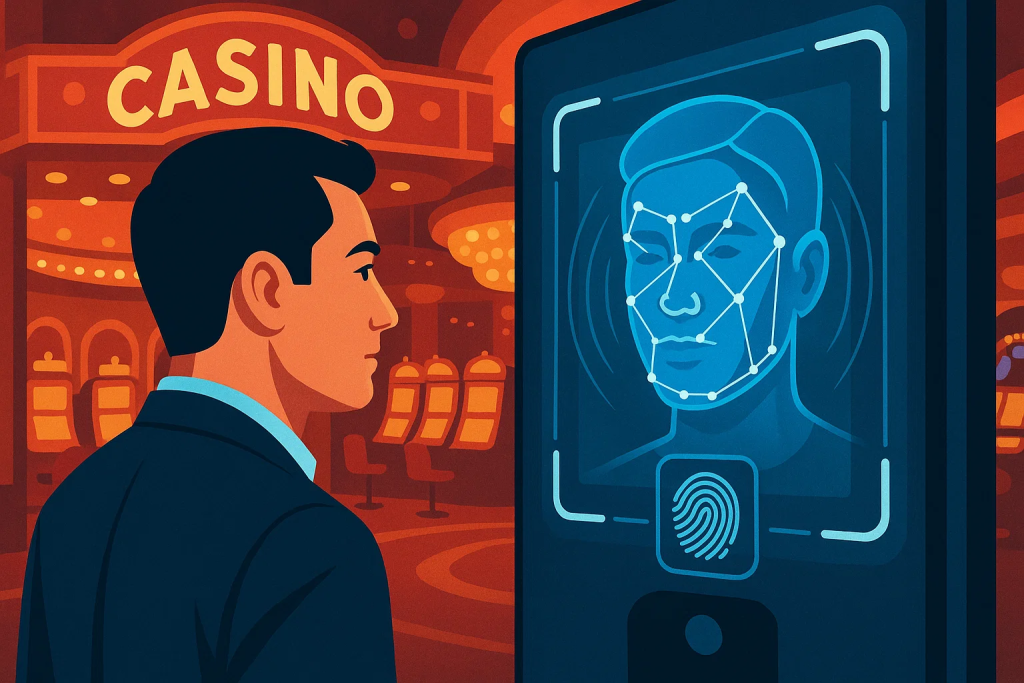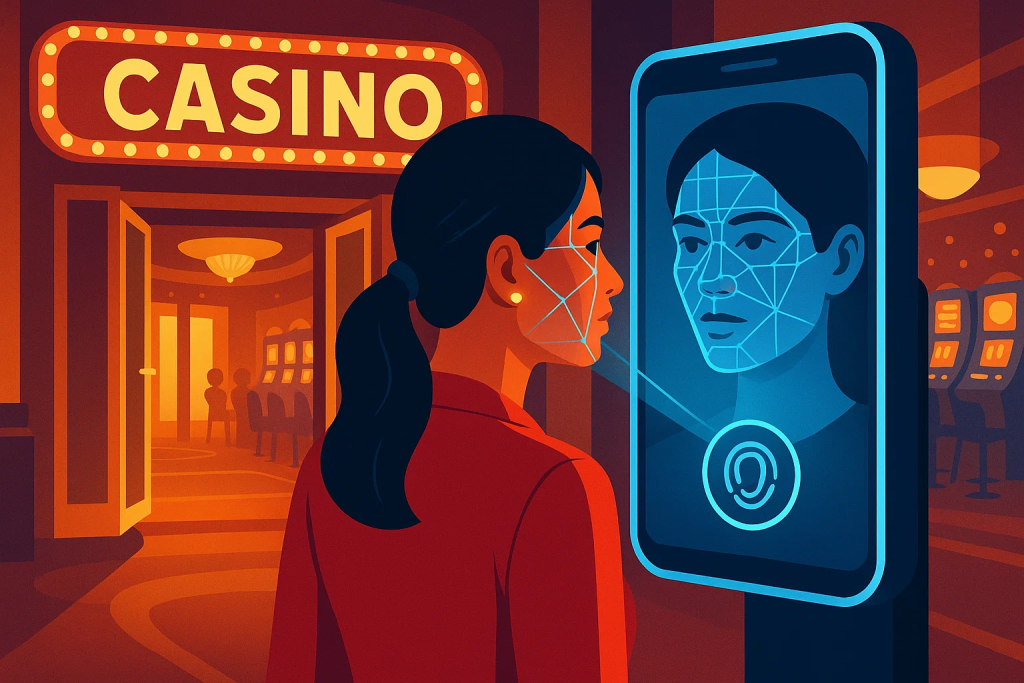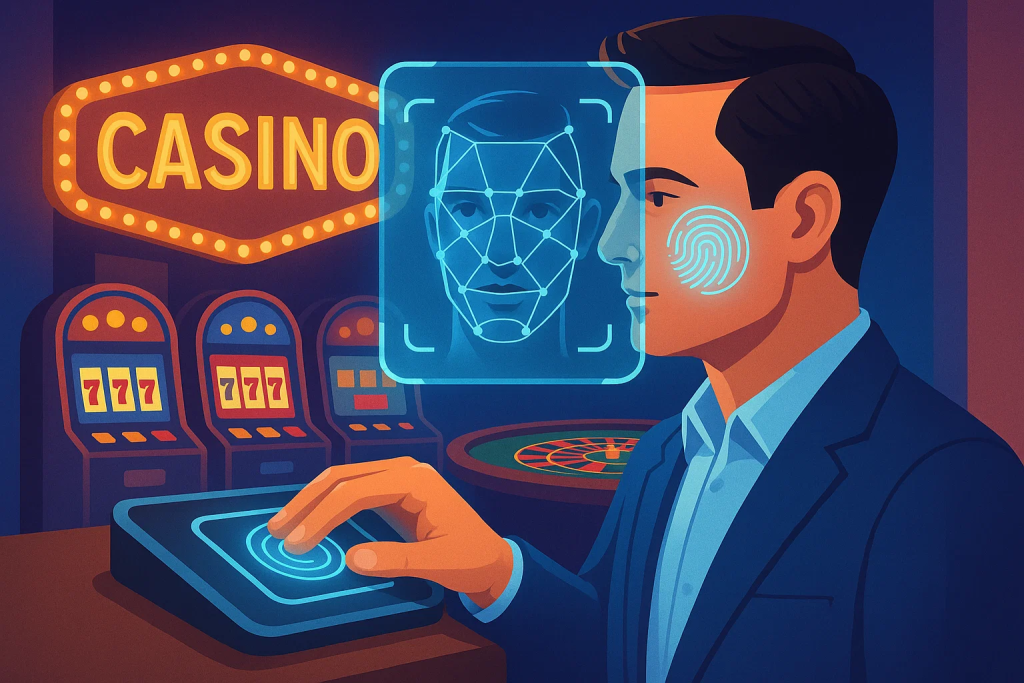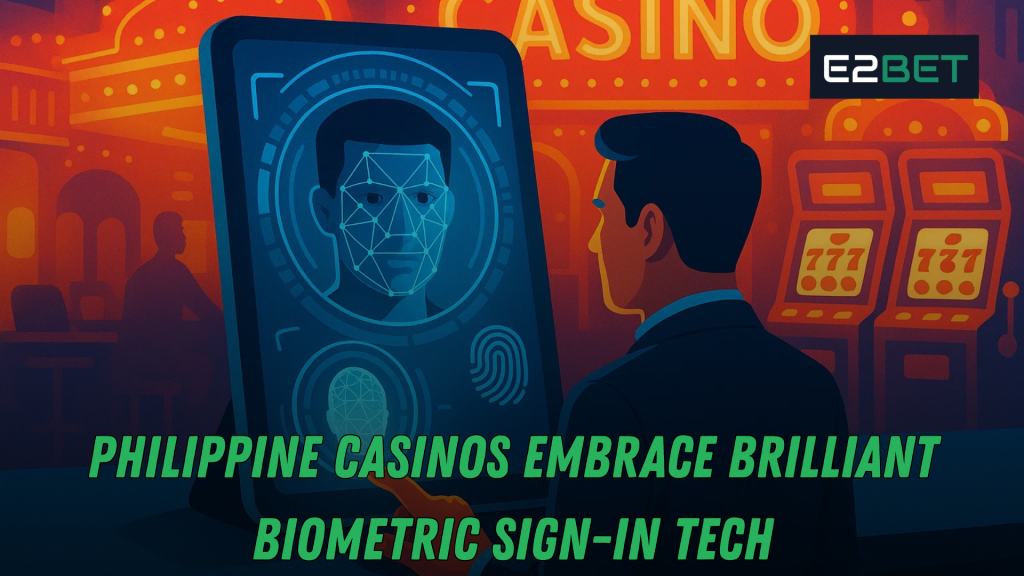Table of Contents
Executive Summary
The solution many properties are piloting and scaling is biometric sign-in that’s designed with privacy, fairness, and hospitality at its core. The Philippine casino and integrated-resort sector is entering a new phase of guest identity, compliance, and personalization. Operators want shorter lines, stronger age-gating, cleaner loyalty data, and better protection for self-excluded patrons—delivered without turning lobbies into checkpoints. This long-form guide maps the entire journey—from choosing sensors and liveness defenses to writing consent copy, measuring ROI, and rolling out a 120-day pilot—so decision-makers can modernize entrances, loyalty desks, and VIP doors with confidence.

What the Technology Is—and What It Isn’t
At its simplest, the system verifies a person, not a plastic card. Sensors capture a unique physical trait (face, iris, palm vein, or fingerprint), convert it into an encrypted mathematical template, and compare that template to a secure reference to determine whether access should be granted. Properly configured, biometric sign-in removes friction while tightening KYC/AML controls, preventing account sharing, and reducing duplicate member profiles. Just as importantly, it’s not a surveillance free-for-all; it should be opt-in, purpose-limited, and accompanied by a respectful non-biometric path for guests who prefer classic ID checks.
Why Philippine Properties Are Moving Now
The Philippines blends a booming tourism pipeline with world-class hospitality and an increasingly sophisticated regulatory posture. Resorts are competing not only on restaurants, rooms, and retail—but also on the speed and dignity of arrival. Guests remember first impressions; executives remember fewer chargebacks and smoother audits. A well-run pilot proves that a few seconds saved at the door can translate into higher loyalty engagement, faster VIP recognition, and better enforcement of self-exclusion—precisely the kind of compounding wins biometric sign-in is meant to deliver.
The Seven-Layer Stack: From Lens to Ledger
Modern deployments follow a layered model that keeps speed high and risk low:
- Sensing – IR/3D cameras for facial capture; FBI-certified readers for prints; near-IR modules for iris or palm.
- Edge liveness – Anti-spoof checks (depth, texture, micro-motion, and randomized prompts) ensure a real, present human.
- Template extraction – Raw images are discarded after conversion; only encrypted templates remain.
- Matching & thresholds – 1:1 verification and 1:N identification run in milliseconds with tunable sensitivity.
- Policy engine – Age gate, property bans, self-exclusion, and AML watches are evaluated instantly.
- Event bus & integrations – Verified events fan out to access control, hotel PMS, cage, POS, and host CRM.
- Audit & governance – Immutable logs and retention policies back every decision—crucial when regulators review biometric sign-in outcomes.
Privacy by Design (Earning Trust, Not Demanding It)
Trust is a product you build, not a checkbox you tick. Start with plain-language signage about what is collected, why it’s needed, how long it’s kept, and how to opt out. Practice data minimization—store the smallest template that still works and delete raw captures immediately. Encrypt in transit and at rest; rotate keys on a schedule; separate the template vault from the guest profile database; and assign rights so no single admin can export the crown jewels. Above all, test fairness: calibrate for different ages, skin tones, and accessibility needs so biometric sign-in performs equitably for every guest.
Where It Delivers the Most Value
Entrances & age-gating. Validate adults in under two seconds, divert self-excluded patrons quietly, and reduce tense moments at the door.
Loyalty desks & kiosks. Retrieve accounts, reprint cards, or redeem offers without rummaging through wallets.
Cage/credit & check-cashing. Tie transactions to real people to combat impersonation and reduce chargebacks.
Hotel check-in. Pair with eKYC and mobile keys to shorten lines and raise upsell conversion.
VIP & salons. Alert hosts the moment recognition completes so greetings feel human, not scripted.
Back-of-house. Lock count rooms, IT closets, and surveillance hubs behind modern access control—anchored by biometric sign-in as the identity source of truth.
Vendor Selection: A 12-Point Checklist
Beware glossy demos that hide weak liveness or biased performance. Ask for independent benchmarks across demographics, PAD (presentation attack detection) results, and latency under load. Prioritize on-prem or hybrid options for sensitive environments, standards compliance (ISO/IEC, FIPS), role-based admin, HSM-backed key management, and clean SDKs for PMS/CRM/ACS and event streaming. Your property doesn’t need the flashiest UI; it needs a durable engine that lets biometric sign-in talk to every system that matters.
Security Architecture That Survives Real Life
Segment identity services into a high-trust zone behind a zero-trust gateway. Enforce TLS 1.3 everywhere; store templates with AES-GCM; and place encryption keys in an HSM or dedicated vault with short-lived tokens. Monitor anomalies such as a single face attempting multiple accounts, and rehearse incident response like you rehearse a fire drill. Plan for graceful degradation, too: publish offline SOPs and maintain local allow-lists so the lobby keeps moving if a link falters—without ever weakening biometric sign-in safeguards.
Guest Experience: Frictionless Beats Flashy
Make the “fast lane” obvious with wayfinding, floor decals, and lighting that flatters rather than blinds. Auto-tilting camera modules accommodate different heights and mobility aids. On-screen guides show where to look; confirmations use friendly microcopy (“Welcome back!”) and simple icons. Most importantly, failures must feel dignified: if matching doesn’t work, an associate completes the process using a classic ID flow without raising eyebrows. That’s how biometric sign-in becomes a welcome, not a wall.
People and Process: The Change-Management Layer
Technology is the easy part; the hard part is habits. Train frontline teams to explain benefits and privacy in a sentence, enroll guests smoothly, and handle exceptions with empathy. Compliance updates retention windows and rule sets; security owns monitoring and red teaming; IT patches and integrates; communications publishes pre-launch FAQs and demo clips. Clear ownership charts prevent the “everybody thought someone else had it” problem that sinks identity projects—even when the biometric sign-in engine is solid.
KPIs and ROI: Numbers Executives Will Believe
Measure before and after: average queue time, age-gating accuracy, self-exclusion interceptions, duplicate profile suppression, fraud incidents, VIP conversion, and CSAT/NPS. Translate metrics into money—labor saved, playtime gained, penalties avoided, and reprint costs eliminated. When dashboards show consistent deltas and clean logs back the story, leadership has what it needs to green-light expansion of biometric sign-in beyond the pilot footprint.
A 120-Day Rollout You Can Copy Tomorrow
Days 1–30 | Plan. Assemble a cross-functional squad; set objectives; align on legal guardrails; map guest journeys; shortlist two vendors.
Days 31–60 | Build. Install sensors; tune lighting; wire a sandbox to PMS/CRM/ACS; draft consent copy and signage; pre-train staff.
Days 61–90 | Pilot. Soft-launch at one entrance and one loyalty touchpoint; monitor accuracy, liveness, throughput, and sentiment; adjust thresholds and camera angles.
Days 91–120 | Expand. Open to general guests; add a second use case; publish KPI results; lock the scale plan. Done right, biometric sign-in becomes a steady drumbeat rather than a one-week stunt.
Risk Register: Name the “What-Ifs” Before They Happen
Presentation attacks. Test against masks, photos, and screens; combine passive and active liveness; rotate prompts.
Bias & fairness. Benchmark regularly and retrain if drift appears.
Downtime. Practice offline SOPs; maintain local allow-lists; reconcile logs on recovery.
Legal & consent. Keep signed records; honor deletions quickly; align retention with stated purpose.
Public perception. Offer non-biometric lanes and phrase messaging in warm hospitality language so biometric sign-in feels like a service, not a demand.
Guest Communications You Can Reuse
- “We verify identity quickly and securely to protect minors, honor self-exclusions, and keep your member benefits safe.”
- “Templates are encrypted, used only for identity and safety, and deleted on request according to policy.”
- “Prefer classic check-in? We’re happy to help at the desk—no pressure.”
Short videos and friendly icons convey what paragraphs can’t. When people understand, biometric sign-in becomes the obvious choice.
Personalization Without Crossing Lines
With explicit consent, recognition can power tasteful touches: a host greeting by name, a dinner reservation reminder, or a discreet note about preferred limits. What it should not do is surprise guests at tables or flash sensitive preferences on public displays. Aggregate movement data can optimize staffing and floor layouts, but individual identities remain shielded—because the promise of biometric sign-in is speed and safety, not voyeurism.

Integrations That Multiply Value
Tie verified events to access control so back-of-house doors stay secure; link to cage and POS so high-risk transactions bind to real people; sync with loyalty to purge duplicates; correlate with surveillance to accelerate investigations. The more systems that trust the same identity backbone, the more your team benefits from the quiet reliability of biometric sign-in across the property.
PAD (Presentation Attack Detection): Beyond “Blink to Pass”
Spoof resistance is a stack, not a checkbox. Use depth and texture analysis to defeat flat images; add randomized prompts (“turn left,” “raise your chin”) to foil pre-recorded clips; rely on IR/3D hardware to handle low light and occlusions; and fuse signals so no single metric decides. Then invite your red team to try—and document—their best attacks. Closing those loops is how you keep biometric sign-in ahead of adversaries.
Overlooked Refinements That Pay Off
Lighting audits at different times of day; multilingual prompts beyond English; mask/hat workflows that guide repositioning rather than scolding; quiet VIP lanes for discretion; seated stations for accessible enrollment. Small touches compounding over months turn a good system into a signature arrival experience supported by biometric sign-in throughout the guest journey.
Three Illustrative Case Patterns (Hypothetical)
Queue-time win. Six kiosks at main doors cut peak waits from 12 minutes to under three; loyalty sign-ins jump double digits; staff redeploy to higher-value tasks.
Fraud clampdown. Cage shifts to template-backed verification; duplicate profiles drop sharply; chargebacks and impersonation attempts fall.
Self-exclusion integrity. Entrances quietly flag banned or self-excluded individuals; associates divert with dignity; escalations decline—all powered by biometric sign-in as a silent guardian.
Governance and Ownership After Go-Live
Define who owns what: compliance/legal controls purpose and retention; IT secures infrastructure; security watches SIEM alerts; privacy audits consent flows; operations keeps SOPs current; and leadership reviews quarterly scorecards. Clear lanes prevent drift and ensure biometric sign-in remains a living program, not a one-time installation.
Budget and Total Cost of Ownership
Expect CapEx for sensors, kiosks, networking, and licenses; OpEx for support, refresh cycles, red-team testing, storage, and training. Count both soft and hard returns: time regained at doors, card reprints eliminated, higher VIP satisfaction, fewer fraud losses, and a stronger regulatory posture. When framed as hospitality infrastructure, biometric sign-in pays for itself by improving service while lowering risk.
Responsible Marketing Around Identity Tech
Market the outcome, not the mechanism: “straight-to-play arrivals,” “safer spaces for everyone,” “members recognized in seconds.” Avoid fear-based narratives. Feature associates—smiling, guiding, helping—as the face of the upgrade. That’s how you keep the heart of the message aligned with the heart of hospitality while normalizing biometric sign-in as a friendly convenience.
Staff Experience and Labor Uplift
Frontline associates want tools that reduce friction, not increase micromanagement. With better identity at the door, they spend less time fixing membership mistakes and more time delivering memorable service. Hosts can focus on high-touch greetings; cage teams can concentrate on accuracy rather than suspicion. Creating that “people win” story inside the company is as critical to adoption as any technical facet of biometric sign-in.
Building a Culture of Consent
Consent flows should be short, understandable, and revisitable. Give guests a way to view what’s on file and to revoke without drama. Train associates to celebrate choice: “Most guests love the speed; if you prefer the classic way, we’re happy to help.” When you normalize both paths, more people choose biometric sign-in because it feels like empowerment, not coercion.
Future-Proofing the Stack
Innovation won’t slow. Expect passkeys and mobile wallets that let matching happen on a guest’s own device; on-device templates that minimize central exposure; federated identity for cross-property trust under strict privacy rules; synthetic-media attack simulations to keep defenses fresh; and privacy-preserving analytics that reveal crowd patterns without exposing individuals. Programs built on modularity will adopt these upgrades fastest—while preserving the core promise of biometric sign-in.

Implementation Stories to Rally Stakeholders
Tell the internal story in three chapters: (1) safety and dignity at the doorstep; (2) time back to guests and teams; (3) a resilient identity backbone that pays dividends across departments. Share early metrics and real guest quotes. When security, compliance, marketing, and operations see their wins in the same dashboard, the case to scale biometric sign-in writes itself.
Common Pitfalls—and How to Dodge Them
- Shiny-demo syndrome. Choose depth over sizzle; demand benchmarks and live tests.
- Under-training. Scripts beat vibes; role-play hard cases before go-live.
- Ignoring lighting. Fix fixtures before you “fix” thresholds.
- No offline plan. Publish SOPs; practice them quarterly.
- Over-collecting data. Store only what you need; delete on schedule. Following these rules keeps biometric sign-in fast, fair, and future-proof.
Call to Action
Pick one high-impact entrance, one loyalty touchpoint, and one back-of-house door. Stand up a pilot in 120 days with clear goals, friendly consent messaging, and a ruthless measurement plan. If you want a neutral checklist for requirements, vendors, integrations, and training, bring your floor plan and KPIs—we’ll help turn a great first impression into a lasting competitive edge powered by biometric sign-in.
Frequently Asked Questions
1) Do guests have to use the system?
No. A respectful program always offers an assisted path with a classic ID check. The fast lane exists to make arrival pleasant and secure; participation in biometric sign-in is optional and consent-based.
2) What happens if the network goes down?
Properties run an offline SOP that maintains flow with manual checks and short-lived local allow-lists, then reconcile records once services return—without compromising the safeguards that define biometric sign-in.
3) How long do casinos keep the data?
Purpose-bound retention windows align with identity and safety objectives; templates are the minimum necessary, encrypted, and deleted upon legitimate request—all core tenets of responsible biometric sign-in.
4) Will masks, hats, or glasses cause failures?
Modern sensors, IR/3D capture, and liveness cues handle partial occlusions; good lighting and on-screen guidance further reduce false rejects so guests glide through biometric sign-in with minimal adjustments.
5) Can this help marketing without being creepy?
With explicit opt-in, yes: recognition cleans identities and times offers better, while keeping sensitive data siloed. Without opt-in, properties restrict biometric sign-in to safety, access, and compliance—full stop.
